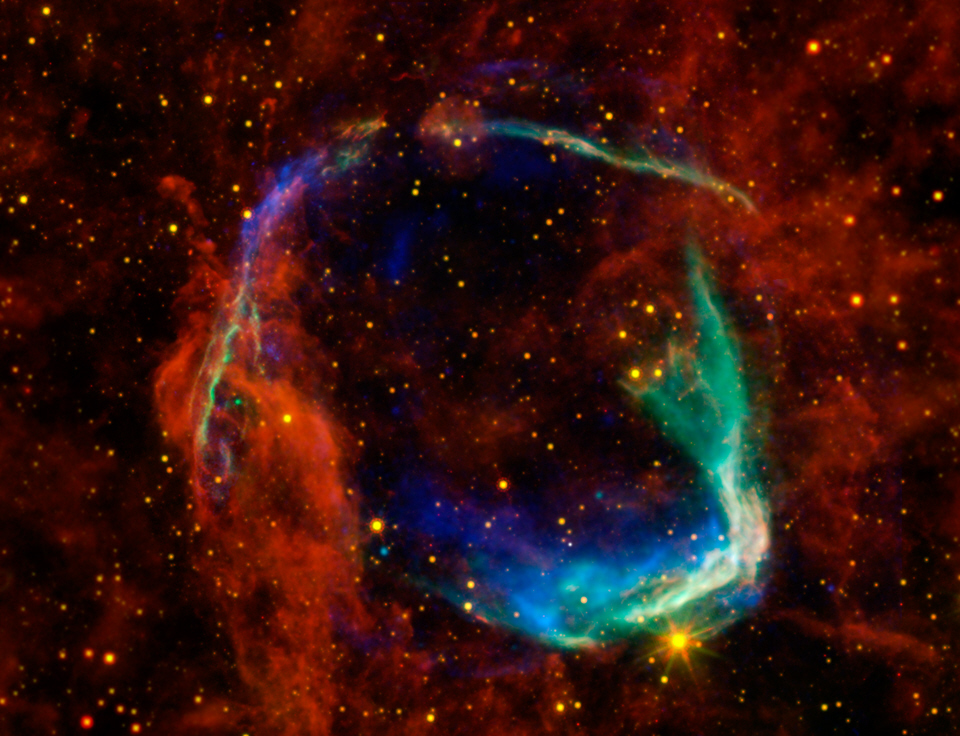Astronomic Guest Star
ω
In the dynasty Han Chinese
nearly two thousand years ago,
sky-watchers could witness with ease
a guest star’s empyreal show.
Believed the first documented
supernova in astro-lore,
it may have been represented
too in Roman writings of yore.
That sidereal mystery
by virtue of sudden debut
was called “guest star” in history
and for eight months lingered in view.
Having characteristic peak
luminosity steady, it
began like a solar death bleak
which shrank to white dwarf bit by bit,
then devoured a fellow star’s mass,
thus to burst in nuclear way
when that vast event came to pass
in a hugely brilliant display
as bright as a galaxy whole
ere it faded from earthly eyes,
slowly losing the shining role
it had played in the ancient skies.
Some fresh observations have shown
that the Milky Way remnant grew
so immense so fast on its own
due to inner winds the dwarf blew,
creating a cavity great
before the explosion took place
followed by swift expansion rate
when it burst in the hollow space.
The occurrence seemingly rare
that infrared scrutiny saw
causing early gazers to stare
brought new knowledge on which to draw.
In colorful multi-wave scene
this celestial image contains
a gaseous shell with bright sheen
of type one-a astral remains.
Four space scopes combined to evoke
a profiled feline head for me,
though not the look of pet to stroke,
but rather cat with eyes that see
with clarity of cosmic sight
how stellar orbs were born and died
plus whether multiverses might
have other poets starry-eyed.
(While for now those bards are quiet,
or at least not yet detected,
would M-theorists deny it
‘mongst the bubble branes suspected?)
To paraphrase an ode sublime
addressed to Grecian urn, by Keats,
whose works endure in timeless time
as dazzling literary feats—
penned in his interrupted prime,
giddy sensuous oasis,
lyric ekphrasis, passioned rhyme,
versus paradoxic stasis.
‘Silent forms, tease us out of thought
as doth eternity’ when mused
upon; still both in poem wrought
within these stanzas have been fused.
The closing quote, much debated,
by each Keatsian scholar sleuth,
finds live beauty elevated
over lifeless artistic truth—
so it has come to me to seem
after immersions myriad
oftentimes in a trancelike dream
for a long-lasting period…
Albeit the critics defend
divergent interpretations
nonetheless this ode, in the end,
will remain for generations.
“Love is my religion,” Keats said,
in a letter to Fanny Brawne.
Sadly, soon after, he was dead,
though his poetry shall live on.
An epitaph engraved for his
tombstone at site of final rest
makes no mention of who he is
at the poet’s precise request.
“Here lies One,” it affirms, “Whose Name
was writ in Water”— such magic
in that vision which conjures fame
grand as oceans, yet so tragic!
The questions that he raised persist
as our gaze to the heavens flies
to far-off wonders that exist,
and a million reveries rise.
For those beauteous shapes, in fact,
of stellary whereabouts strange
seem fixed in space, caught in the act,
yet they’ve already gone through change
by the time we see the traces
in a temporal depiction
of their distant cosmic faces,
plus astronomers’ description…
In reality beauty lies
with enlightenment’s golden glow,
the only truth that never dies,
which is Nam Myoho Renge Kyo.
~ Harley White
* * * * * * * * * *
Inspiration derived from the following sources…
John Keats ~
his life, Ode on a Grecian Urn (see also
here) and
reflections on the poem...
RCW 86: All Eyes on Oldest Recorded Supernova...
SN 185...
NASA Telescopes Help Solve Ancient Supernova Mystery...
2,000-Year-Old Supernova Mystery Solved By NASA Telescopes...
RCW 86, a supernova remnant between Circinus and Centaurus...
RCW 86: Historical Supernova Remnant
Further inspiration derived from the teachings and writings of Nichiren Daishōnin…
Nam Myōhō Renge Kyō means to devote our lives to and found them on (Nam[u]) the Utterness of the Dharma (Myōhō) [entirety of existence, enlightenment and unenlightenment] permeated by the underlying white lotus flower-like mechanism of the interdependence of cause, concomitancy and effect (Renge) in its whereabouts of the ten [psychological] realms of dharmas [which is every possible psychological wavelength] (Kyō).
The reason that we continually recite Nam Myōhō Renge Kyō
Infrared images from NASA’s Spitzer Space Telescope and WISE are combined with X-ray data from the Chandra X-ray Observatory and ESA’s XMM-Newton Observatory in this image of RCW 86.

Credit: X-ray: XMM-Newton, Chandra / IR: WISE, Spitzer
| Table of Contents |
|